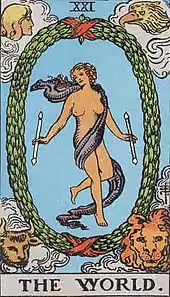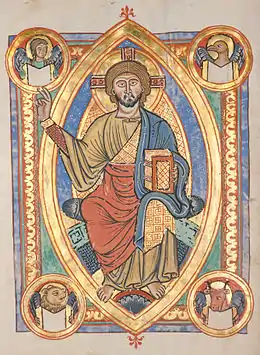
The World (XXI) is the 21st trump or Major Arcana card in the tarot deck. It can be incorporated as the final card of the Major Arcana or tarot trump sequence (the first or last optioned as being "The Fool" (0). It is associated with the 22nd letter of the Hebrew alphabet, 'Tau', also spelled 'Tav' or 'Taw'.
Description

In the traditional Tarot of Marseilles, as well as the later Rider–Waite tarot deck, a naked woman hovers or dances above the Earth holding a baton in each hand, surrounded by a wreath, being watched by the four living creatures (or hayyoth) of Jewish mythology: a man, a lion, an ox, and an eagle. This depiction parallels the tetramorph used in Christian art, where the four creatures are used as symbols of the four Evangelists. Some astrological sources explain these observers as representatives of the natural world or the kingdom of beasts. According to astrological tradition the Lion is Leo—a fire sign, the Bull or calf is Taurus—an earth sign, the Man is Aquarius—an air sign, and the Eagle is Scorpio—a water sign.[1] These signs are the four fixed signs and represent the classical four elements.
In some decks the wreath is an ouroboros biting its own tail. In the Thoth Tarot designed by Aleister Crowley, this card is called "The Universe."
Interpretation
According to A.E. Waite's 1910 book The Pictorial Key to the Tarot, the World card carries several divinatory associations:[2]
21.THE WORLD—Assured success, recompense, voyage, route, emigration, flight, change of place. Reversed: Inertia, fixity, stagnation, permanence.
The World represents an ending to a cycle of life, a pause in life before the next big cycle beginning with the fool.[3] The figure is male and female, above and below, suspended between the heavens and the earth. It is completeness. It is also said to represent cosmic consciousness; the potential of perfect union with the One Power of the universe.[4] It tells us full happiness is to also give back to the world: sharing what we have learned or gained. As described in the book The New Mythic Tarot by Juliet Sharman-Burke and Liz Greene (p. 82), the image of the woman (Hermaphroditus in Greek Mythology) is to show wholeness unrelated to sexual identification but rather of combined male and female energy on an inner level, which integrates opposites traits that arise in the personality charged by both energies. Opposite qualities between male and female that create turmoil in our life are joined in this card, and the image of becoming whole is an ideal goal, not something that can be possessed rather than achieved.
According to Robert M. Place in his book The Tarot,[5] the four beasts on the World card represent the fourfold structure of the physical world—which frames the sacred center of the world, a place where the divine can manifest. Sophia, meaning Prudence or Wisdom (the dancing woman in the center), is spirit or the sacred center, the fifth element. Prudence is the fourth of the Cardinal virtues in the tarot.[5] The lady in the center is a symbol of the goal of mystical seekers. In some older decks, this central figure is Christ, whereas in others it is Hermes. Whenever it comes up, this card represents what is truly desired.[6]
In other media
In the manga JoJo's Bizarre Adventure: Stardust Crusaders, tarot cards are used to name the character's powers, named 'Stands'. The main antagonist of Stardust Crusaders, DIO, has a Stand named The World, named after The World card. This stand has the power to stop time for a maximum of 9 seconds whenever DIO commands it to, and he can move during frozen time. In Steel Ball Run, an alternate version of DIO, Diego Brando, later gains this Stand after being summoned by Funny Valentine.
In the film Cryptozoo, a tarot reading is done with the Waite-Smith Deck that reveals The World card as part of the protagonist's journey.
In The House of the Dead, each of its bosses in the mainline series are named after the Major Arcana Tarot Cards (excluding The Devil.) The final boss of its fourth installment (Type β) is named after The World card, being the most powerful of Goldman's creations and a successor to his previous creature, 'The Emperor.' The World is a crystalline humanoid with cryokinesis, frozen from the waist down. The World evolves into a new form every time the players defeat it.
In Good Omens Aziraphale and Crowley's tarot card is number 21, titled "The World".
References
Bibliography
- Case, Paul Foster (1947). The Tarot. Builders of the Adytum.
- DeVore, Nicholas (1947). Encyclopedia of Astrology. Philosophical Library.
- Place, Robert M. (2005). The Tarot: History, Symbolism and Divination. New York: Jeremy P. Tarcher/Penguin. ISBN 1-58542-349-1.
- Waite, Arthur (1911). The Pictorial Key to the Tarot. London: W. Rider.
- Wood, Juliette (1998). "The Celtic Tarot and the Secret Tradition: A Study in Modern Legend Making". Folklore. 109 (1–2): 15–24. doi:10.1080/0015587x.1998.9715957.